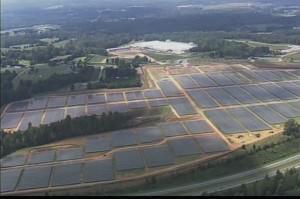 In an article recently released by the local Denver publication, Westword, the National Renewable Energy Lab’s (NREL) expansion into private land is brought to light. As of the writing of this post, the article titled, “What Has NREL Done for Public Good?” is nestled next to a photo gallery of Jello-wrestling and luchadores. While the title of the article seems to call into question NREL’s very existence, it actually mostly covers the fact that Jefferson County, in which NREL is located, used eminent domain to acquire land from nearby neighbors of the lab in order to build a necessary second access road to the expanding site.
In an article recently released by the local Denver publication, Westword, the National Renewable Energy Lab’s (NREL) expansion into private land is brought to light. As of the writing of this post, the article titled, “What Has NREL Done for Public Good?” is nestled next to a photo gallery of Jello-wrestling and luchadores. While the title of the article seems to call into question NREL’s very existence, it actually mostly covers the fact that Jefferson County, in which NREL is located, used eminent domain to acquire land from nearby neighbors of the lab in order to build a necessary second access road to the expanding site.
This got me thinking that as it becomes necessary to expand solar, wind, geothermal, biomass, and hydro sites to increase clean energy generation, how much land will people be willing to give up for clean energy? As more and more clean energy projects come online, I always notice how huge these solar panel sites are. Many pictures show huge arrays of solar panels stretching over a countryside, which are more often than not closed off by chain link fence. For example, the Lawrenceville School, located near Princeton in New Jersey, recently added a 6.1 megawatt solar farm that covers nearly 30 acres and generates nearly 90% of the school electricity needs. Looking at the photos of the solar farm, though, you can understand why some nearby residents would be less than ecstatic about the covering of rolling countryside in favor of metal and glass panels.
By no means am I saying that solar arrays shouldn’t be developed, but when people think about huge wind farms and solar arrays, I don’t think they necessarily consider that these huge projects may be in lots adjacent to their current places of living. Even though solar isn’t the most productive in the state of New Jersey, an explosion of solar sites, including the one at the Lawrenceville School, have come online in the past year. This means that people living next to a countryside last year may now find themselves living next to a solar array this year.
The above examples represent renewable projects being built nearby private land. It is a very different scenario when developers forcibly take land from private owners for construction. The Westword article about NREL refers to an example of eminent domain being used to construct a new road, but eminent domain is already being used by oil and gas companies to build wells and pipelines existing within or crossing through private land. I suppose I could say lucky for us oil is relatively energy dense and doesn’t require nearly the amount of land coverage that renewable energy projects will require. Of course, the case can be made that in the quest for oil, we have “used” much land. Two examples of this are the digging of Canadian oil sands and the destruction of Gulf Coast waters from the Deepwater Horizon spill.
What I’m wondering about when it comes to using eminent domain for renewable projects, though, is how people will respond if it is determined that their land is highly productive for solar or wind, and the government forcibly takes this land in order to build solar arrays or wind turbines. Can people be forced to install solar panels on their homes? Will tax subsidies or the opportunity to sell excess electricity to utility companies be enough of a benefit for homeowners to willfully install rooftop solar panels, allow construction of ground-mounted solar arrays or wind turbines? Or will there eventually be a mandate to force installation? Many of the most productive areas for solar energy are within tribal reservations in the American southwest. This means people living in these areas have the opportunity to make a lot of money selling land to renewable developers, but no one can blame them if they would rather keep rolling countrysides or untouched landscapes.
As I stated in my past article about renewable project scales, if we are going to maintain the current energy-guzzling living standards of the average American, renewable projects are going to need to be large and intrusive. I wonder if this means we will eventually have to force the acquisition of lands in order to build solar arrays, wind farms, geothermal wells, or biofuel croplands.

